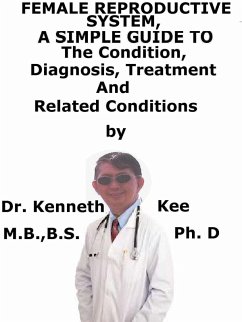The female reproductive system is the organs in the female human body responsible for the pregnancy and delivery of a human baby.
The ovaries in the system produces the female egg cells needed for reproduction, called the ova or oocytes.
The system is planned to transport the ova to the site of fertilization.
Conception or the fertilization of an egg by a sperm normally happens in the fallopian tubes.
Then the fertilized egg will implant into the walls of the uterus, beginning pregnancy.
If fertilization and/or implantation do not take place, the inner linings of the uterine wall will start to shed as blood
Also, the female reproductive system produces female sex hormones that keep the reproductive cycle going.
The main external structures are:
Labia majora: surround and protect the other external reproductive organs.
The labia majora are large and fleshy, and are similar to the scrotum in males.
The labia majora have sweat and oil-secreting glands.
Labia minora: may be very small or up to 2 inches wide.
They are located just within the labia majora, and enclose the openings to the vagina and urethra
Bartholin's glands: These glands are found besides the vaginal opening and produce a mucus secretion.
Clitoris: The two labia minora join at the top at the clitoris, a small, sensitive protrusion that is similar to the penis in males.
The clitoris is enclosed by a fold of skin, called the prepuce, which is similar to the foreskin at the end of the penis.
Like the penis, the clitoris is very sensitive to stimulus and can become erect.
The function of the external structures is:
1.To enable sperm to enter the body
2.To protect the internal genital organs from infectious organisms.
The internal reproductive organs in the female are:
Vagina: is a canal that connects the cervix to the outside of the body.
It also is called the birth canal.
Uterus: is a hollow, pear-shaped organ that allows a developing fetus to grow inside its wall.
The uterus is divided into:
1.The cervix is the lower part that opens into the vagina, and
2.The main body of the uterus, termed the corpus.
The corpus can easily enlarge to hold a developing baby.
The cervix permits sperm to enter to fertilize the egg and allows the menstrual blood to exit.
Ovaries: are small, oval-shaped glands that are found on either side of the uterus.
The ovaries form the eggs and the female hormones.
Fallopian tubes: are narrow tubes that are connected to the upper part of the uterus and work as tunnels for the ova to travel from the ovaries to the uterus.
Conception, the fertilization of an egg by a sperm, normally happens in the fallopian tubes.
The fertilized egg then travels to the uterus to implant into the lining of the uterine wall.
Menstrual Cycle
Females of reproductive age have cycles of hormonal activity that occur at about one-month intervals.
With every cycle, a woman's body prepares for a possible pregnancy.
The average menstrual cycle takes about 28 days and happens in phases:
There are 4 major hormones:
1.Follicle-stimulating hormone,
2.Luteinizing hormone,
3.Estrogen,
4.Progesterone.
Follicular Phase:
FSH and LH are secreted from the brain and move in the blood to the ovaries
The hormones cause the growth of about 15 to 20 eggs in the ovaries
1 follicle in one ovary becomes dominant
Ovulatory Phase: mid period
Dominant follicle releases its egg
The fimbriae brush the egg into the tube
The thick mucus catches the man's sperm
Luteal Phase:
Progesterone forms.
The fertilized egg in fallopian tube move to implant into the uterus.
The pregnancy begins.
TABLE OF CONTENT
Introduction
Chapter 1 Female Reproductive System
Chapter 2 Pregna...
Dieser Download kann aus rechtlichen Gründen nur mit Rechnungsadresse in A, B, CY, CZ, D, DK, EW, E, FIN, F, GR, H, IRL, I, LT, L, LR, M, NL, PL, P, R, S, SLO, SK ausgeliefert werden.


